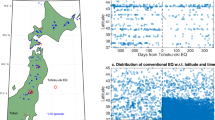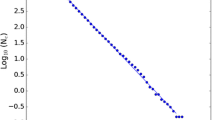Abstract
The paper studies the statistical properties of deep earthquakes around North Island, New Zealand. We first evaluate the catalogue coverage and completeness of deep events according to cusum (cumulative sum) statistics and earlier literature. The epicentral, depth, and magnitude distributions of deep earthquakes are then discussed. It is worth noting that strong grouping effects are observed in the epicentral distribution of these deep earthquakes. Also, although the spatial distribution of deep earthquakes does not change, their occurrence frequencies vary from time to time, active in one period, relatively quiescent in another. The depth distribution of deep earthquakes also hardly changes except for events with focal depth less than 100 km. On the basis of spatial concentration we partition deep earthquakes into several groups—the Taupo-Bay of Plenty group, the Taranaki group, and the Cook Strait group. Second-order moment analysis via the two-point correlation function reveals only very small-scale clustering of deep earthquakes, presumably limited to some hot spots only. We also suggest that some models usually used for shallow earthquakes fit deep earthquakes unsatisfactorily. Instead, we propose a switching Poisson model for the occurrence patterns of deep earthquakes. The goodness-of-fit test suggests that the time-varying activity is well characterized by a switching Poisson model. Furthermore, detailed analysis carried out on each deep group by use of switching Poisson models reveals similar time-varying behavior in occurrence frequencies in each group.















Similar content being viewed by others

References
Adams, R.D. (1963) Source characteristics of some deep New Zealand earthquakes, New Zealand Journal of Geology and Geophysics, 6, 209–220.
Adams, R. D. and Ferris, B. G. (1976) A further earthquake at exceptional depth beneath New Zealand, New Zealand Journal of Geology and Geophysics, 19, 269–273.
Aki, K. (1965) Maximum likelihood estimate of b in the formula logN=a-bM and its confidence limits, Bull. Earthquake Res. Inst. Tokyo Univ., 43, 237–239.
Anderson, H. and Webb, T. (1994) New Zealand seismicity: patterns revealed by the upgraded National Seismograph Network, New Zealand Journal of Geology and Geophysics, 37, 477–493.
Boddington, T., Parkin, C. J. and Gubbins, D. (2004) Isolated Deep Earthquakes beneath the North Island of New Zealand, Geophys. J. Int., 158, 972–982.
Chong, F. S. (1983) Time-Space-Magnitude interdependence of upper crustal earthquakes in the main seismic region of New Zealand, New Zealand Journal of Geology and Geophysics, 26, 7–24.
Daley, D. J. and Vere-Jones, D. (2008) An Introduction to the Theory of Point Processes. Vol 2, Springer.
Deng, L. and Mark, J. W. (1993) Parameter estimation for Markov modulated Poisson processes via the EM algorithm with time discretization, Telecommunication Systems, 321-338, 1, 1993.
Fischer, W. and Meier-Hellstern, K. (1992) The Markov-modulated Poisson process (MMPP) cookbook, Performance Evaluation, 18, 149–171.
Frohlich, C. (1989) The Nature of Deep-Focus Earthquakes, Ann. Rev. Earth Planet. Sci., 17, 227–254.
Frohlich, C. (2006) Deep Earthquakes. Cambridge University Press, UK.
Gibowicz, S.J. (1972) The relationship between teleseismic body-wave magnitude m and local magnitude M L from new zealand earthquakes. Bull. Seismol. Soc. Am., 62, 1-11.
Harte, D. and Vere-Jones, D. (1999) Differences in Coverage between the PDE and New Zealand local earthquake catalogues, New Zealand Journal of Geology and Geophysics, 42, 237–253.
Harte, D. (2006) User’s guide for the Statistical Seismological Library, http://www.statsresearch.co.nz/software.html.
Habermann, R.E. (1983) Teleseismic detection in the Aleutian island arc, Journal of Geophysical Research, 88, B6, 5056–5064.
Habermann, R.E. (1987) Man-made changes of seismicity rates. Bulletin of Seismological Society of American, 77, 1, 141–159.
McCaffrey, R. (1994) Dependence of earthquake size distributions on convergence rates at subduction zones. Geophysical Research Letters, Vol. 21, No. 21, 2327–2330.
Molnar, P. (1979) Earthquake recurrence intervals and plate tectonics. Bull. Seismol. Soc. Am., 69, 115–133.
Ogata, Y. (1988) Statistical Models for Earthquake Occurrences and Residual Analysis for Point Processes, JASA, 83, 9–27.
Ogata, Y. (1998) Space-Time Point-Process Models for Earthquake Occurrences, Annals of the Institute of Statistical Mathematics, 24, 379-402.
Omori, F. (1894) On the aftershocks of earthquakes, Journal of the College of Science, Imperial University of Tokyo, 7, 111–200.
Reyners, M. (1989) New Zealand Seismicity 1964–87:an interpretation, New Zealand Journal of Geology and Geophysics, 32, 307–315.
Rydén, T. (1996) An EM algorithm for estimation in Markov-modulated Poisson processes, Computational Statistics & Data Analysis, 21, 431–447.
Vere-Jones, D., Turnovsky, S. and Eiby, G.A.(1964) A statistical survey of earthquakes in the main seismic region of New Zealand, Part 1-time trends in the pattern of recorded activity, New Zealand Journal of Geology and Geophysics, 7, 4, 722–744.
Vere-Jones, D. and Davies, R. B. (1965) A Statistical Survey of Earthquakes in the Main Seismic Region of New Zealand, Part 2–Time Series Analysis, New Zealand Journal of Geology and Geophysics, 9, 3, 251–283.
Vere-Jones, D. (1978) Space Time Correlations for Microearthquakes: A Pilot Study, Advances in Applied Probability, 10, 73–87.
Wadati, K. (1928) Shallow and deep earthquakes, Geophys. Mag. 1, 161–202.
Xiaogu, Z. and Vere-jones, D. (1991) Application of Stress Release Models to Historical Earthquakes from North China, PAGEOPH, 135, 4, 559–576.
Acknowledgements
We are grateful to David Harte for his suggestions in preparing this manuscript. Financial support from NZIMA (New Zealand Institute of Mathematics and its Applications) and NSF of China (No. 10871026) is acknowledged.
Author information
Authors and Affiliations
Corresponding author
Rights and permissions
About this article
Cite this article
Shaochuan, L., Vere-Jones, D. Large Occurrence Patterns of New Zealand Deep Earthquakes: Characterization by Use of a Switching Poisson Model. Pure Appl. Geophys. 168, 1567–1585 (2011). https://doi.org/10.1007/s00024-011-0263-9
Received:
Revised:
Accepted:
Published:
Issue Date:
DOI: https://doi.org/10.1007/s00024-011-0263-9



